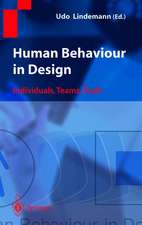A Practical Guide to Bio-inspired Design
Autor Helena Hashemi Farzaneh, Udo Lindemannen Limba Engleză Hardback – 26 iul 2018
Bio-inspired design (also called biomimetics or biomimicry) is a promising approach for the development of innovative technical products – not only in mechanical engineering, but also in areas such as material science and even computer engineering. Innovations such as humanoid robots or multifunctional materials have shown the potential of bio-inspired design. However, in industrial companies, bio-inspired design remains an “exotic” approach which is rarely used in innovation practice. One reason for this is a lack of knowledge on how to implement bio-inspired design in practice. Therefore, this guide book was written to explain the application of bio-inspired design methods and tools. The target groups are professional engineers and biologists, as well as students of both disciplines.
The book presents a selection of methods for specific activities in bio-inspired design, namely: planning a bio-inspired design project, abstraction, search, analysis and comparison, and transferof analogies. Factsheets give an overview of each method, its advantages and challenges, and its suitability for different bio-inspired design approaches and scenarios. To facilitate understanding, all methods are explained with the help of the same example. In addition, ten best practice examples show the practical applicability of bio-inspired design.
The book presents a selection of methods for specific activities in bio-inspired design, namely: planning a bio-inspired design project, abstraction, search, analysis and comparison, and transferof analogies. Factsheets give an overview of each method, its advantages and challenges, and its suitability for different bio-inspired design approaches and scenarios. To facilitate understanding, all methods are explained with the help of the same example. In addition, ten best practice examples show the practical applicability of bio-inspired design.
| Toate formatele și edițiile | Preț | Express |
|---|---|---|
| Paperback (1) | 781.94 lei 43-57 zile | |
| Springer Berlin, Heidelberg – 10 ian 2019 | 781.94 lei 43-57 zile | |
| Hardback (1) | 896.08 lei 22-36 zile | |
| Springer Berlin, Heidelberg – 26 iul 2018 | 896.08 lei 22-36 zile |
Preț: 896.08 lei
Preț vechi: 1092.78 lei
-18% Nou
Puncte Express: 1344
Preț estimativ în valută:
171.52€ • 186.37$ • 144.17£
171.52€ • 186.37$ • 144.17£
Carte disponibilă
Livrare economică 31 martie-14 aprilie
Preluare comenzi: 021 569.72.76
Specificații
ISBN-13: 9783662576830
ISBN-10: 366257683X
Pagini: 240
Ilustrații: X, 262 p. 85 illus., 10 illus. in color.
Dimensiuni: 168 x 240 mm
Greutate: 0.59 kg
Ediția:1st ed. 2019
Editura: Springer Berlin, Heidelberg
Colecția Springer Vieweg
Locul publicării:Berlin, Heidelberg, Germany
ISBN-10: 366257683X
Pagini: 240
Ilustrații: X, 262 p. 85 illus., 10 illus. in color.
Dimensiuni: 168 x 240 mm
Greutate: 0.59 kg
Ediția:1st ed. 2019
Editura: Springer Berlin, Heidelberg
Colecția Springer Vieweg
Locul publicării:Berlin, Heidelberg, Germany
Cuprins
Introduction.- Planning of a Bio-inspired Design Project.- Abstraction.- Search.- Analysis and Comparison.- Transfer of Analogies.- Fact sheets.- Refernces. Appendix. Index.
Notă biografică
Dr.-Ing. Helena Hashemi Farzaneh is a researcher at the Technical University of Munich. She studied mechanical engineering and received her PhD studying the collaboration between engineers and biologists. Her current research focuses on bio-inspired design and its integration into the innovation process.
Professor Dr.-Ing. Udo Lindemann is a professor emeritus of the Technical University of Munich. He was formerly head of the Institute of Product Development (1995-2016). Udo Lindemann is active on several advisory boards, the National Academy of Science and Engineering, and is part of the Bavarian Industry Association Future council. For his outstanding achievements, he received the honorary title of “TUM Emeritus of Excellence”.
Textul de pe ultima copertă
Bio-inspired design (also called biomimetics or biomimicry) is a promising
approach for the development of innovative technical products – not only in
mechanical engineering, but also in areas such as material science and even computer
engineering. Innovations such as humanoid robots or multifunctional
materials have shown the potential of bio-inspired design. However, in industrial
companies, bio-inspired design remains an “exotic” approach which is rarely
used in innovation practice. One reason for this is a lack of knowledge on how to
implement bio-inspired design in practice. Therefore, this guide book was written
to explain the application of bioinspired design methods and tools. The target
groups are professional engineers and biologists, as well as students of both disciplines.
The book presents a selection of methods for specific activities in bio-inspired
design, namely: planning a bio-inspired design project, abstraction, search, analysis
and comparison, and transfer of analogies. Factsheets give an overview of each
method, its advantages and challenges, and its suitability for different bio-inspired
design approaches and scenarios. To facilitate understanding, all methods are
explained with the help of the same example. In addition, ten best practice examples
show the practical applicability of bio-inspired design.
The Authors
Dr.-Ing. Helena Hashemi Farzaneh is a researcher at the Technical University of
Munich. She studied mechanical engineering and received her PhD studying the
collaboration between engineers and biologists. Her current research focuses on
bio-inspired design and its integration into the innovation process.
Professor Dr.-Ing. Udo Lindemann is a professor emeritus of the Technical University
of Munich. He was formerly head of the Institute of Product Development
(1995–2016). Udo Lindemann is active on several advisory boards, the National
Academy of Science and Engineering, and is part of the Bavarian Industry Association
Future council. For his outstanding achievements, he received the honorary
title of “TUM Emeritus of Excellence”.
Caracteristici
State-of-the-art research on bio-inspired design approaches Guidelines for procedures, methods, and tools for bio-inspired design Fact sheets for methods all based on the same example throughout Best practice examples showcase successful bio-inspired products























